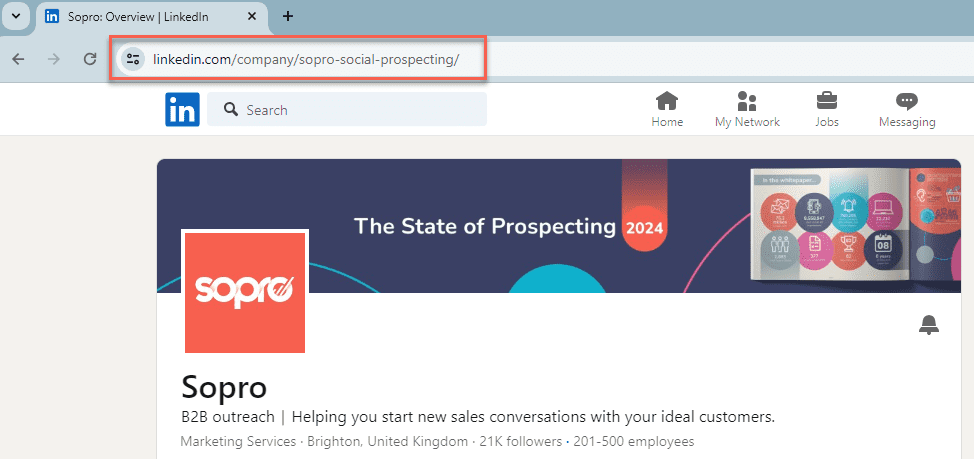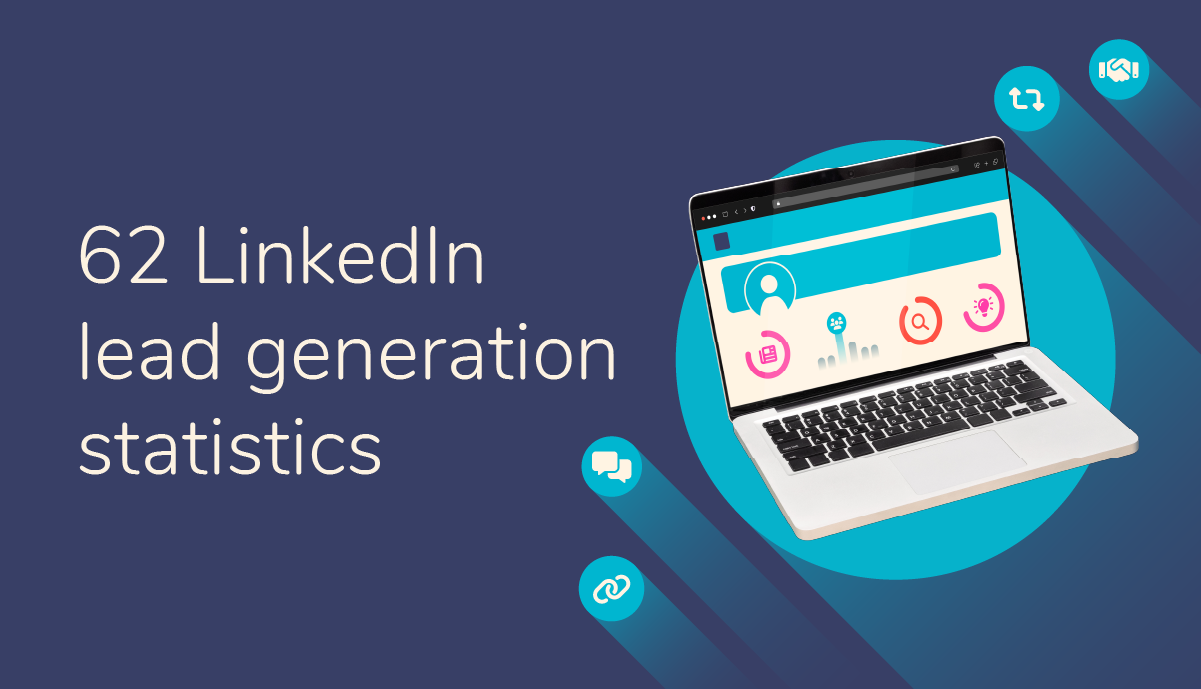How to optimise your LinkedIn company page

LinkedIn is the go-to professional networking platform, with more than 67 million companies trying to attract the attention of more a billion users via LinkedIn lead generation. This makes it a key tool for B2B business generation.
Our latest State of Prospecting report reveals that 53% of companies use it for prospecting, and that B2B buyers are very receptive to that outreach – social media is second only to email on their list of preferences.
Your LinkedIn company profile serves as the initial point of contact between your business and potential clients, partners, or employees. A good LinkedIn presence can significantly impact that all-important first impression. It’s not just a digital façade; it’s a reflection of your brand’s professionalism, values, and commitment to engagement.
So, you want to be looking your best.
Whether you are posting organically, using paid advertising, or your sales team are sending outreach messages, it’s essential you make sure everything is squeaky clean and crystal clear on your company page, as much of the traffic you generate will end up here at some point.
Here are eight instantly actionable tips for making sure your LinkedIn company page really does the business.
1. Personalise your URL
All company pages and profiles are given a standard-issue – and usually rather clumsy – LinkedIn URL by default. But many are not aware that you are free to tidy things up by creating custom links.
It’s easy enough to do, as long as you have been assigned page admin status.
- Simply sign in to your page admin centre
- Click the admin tools dropdown
- And from here select the public URL option where you can make any changes you wish.
You need not worry about losing traffic that might be directed to your old URL, as creating a vanity URL for your page does not take down your main one.

There are, however, a few LinkedIn policies it is worthwhile being aware of.
These include limiting how often you change your URL to once in every 30 days and making any dropped URLs available for others to claim after 365 days.
2. Add your specialisms
Head to your company overview in the About tab. The specialties section is the ideal opportunity to present your core strengths in an instantly scannable format. This part of your profile is not just a list; it’s a powerful tool for communicating your business’s expertise and areas of excellence.
It is also where you can use keywords to help LinkedIn’s algorithm understand exactly which sorts of search results you should feature in. But to make the most of it, consider these in-depth strategies:
Be specific and strategic
- Choose specialties wisely: Select keywords and phrases that accurately reflect your company’s services, products, and areas of expertise. Think about the terms your potential clients might use when searching for the services you offer.
- Industry relevance: Ensure the specialties you list are relevant to your industry. This relevance helps LinkedIn’s algorithm match your profile with the right searches, increasing your visibility to the most appropriate audience.
Use keyword research
- Research keywords: Use keyword research tools to find terms that are popular and relevant to your business. Including these keywords can improve your company’s discoverability on LinkedIn and search engines.
- Competitor analysis: Look at the profiles of competitors or industry leaders. Note which specialties they list and consider how you can differentiate your business while still remaining searchable.
Update regularly
- Reflect changes and growth: As your business evolves, so should your specialties. Regular updates ensure your LinkedIn profile remains accurate and reflective of your current capabilities and focus areas.
- Seasonal or trending specialties: If your business has seasonal peaks or you’re capitalising on a trending topic, update your specialties to reflect this. It can increase your profile’s relevance and timeliness.
3. Brand consistency
Make sure you are presenting a consistent brand by adding a quality image of your logo and using an attractive cover photo. You can also use the cover image to promote events or marketing campaigns.
Make sure you stick to the right image dimensions. It’s a good idea to encourage company employees to use that same cover image, so that your brand is reinforced any time a prospect interacts with an employee.
4. Show off your value proposition
Every LinkedIn company page has a headline. This is often the first impression people will have of your company… and you only have 120 characters to get it right!

This short blurb is a powerful tool for branding and visibility. It’s your chance to immediately communicate your unique value proposition, distinguishing your brand in a crowded marketplace.
Including relevant keywords boosts your profile’s searchability on LinkedIn, making it easier for potential clients, partners, and talent to find you.
Think of your LinkedIn headline as your business’s digital handshake. It should be engaging, informative, and reflective of your brand’s mission and expertise.
Crafting a headline that what you offer, but focusing on the benefit to your potential customers, can significantly impact how viewers perceive your brand, and encourages further exploration of your profile.
5. Optimise for impact and visibility
Optimising your LinkedIn page must be done on two distinct levels to ensure maximum impact and visibility.
On one level, your page must inform key stakeholders such as prospects, suppliers, potential employees, and partners. They all visit your LinkedIn to understand what your company stands for, its achievements, and how it differentiates itself in the market. Your company overview is the hub where this diverse audience should find everything they need to know, told in a compelling way.

The initial lines of your company’s overview are particularly critical. They need convey your brand’s identity and mission. This segment acts as the hook; it’s what’s visible on all devices without the need for scrolling. It should be powerful that it entices viewers to delve deeper into your profile.
On another level, your page must be optimised to LinkedIn’s algorithm, ensuring your company appears in relevant searches. By embedding targeted keywords within your overview, you not only clarify your company’s focus and expertise but also enhance your visibility.
This dual approach to optimisation ensures that your LinkedIn page not only attracts but also engages the right audience, setting the stage for meaningful connections and opportunities.
6. Get social
It is important that the groups that are important to you have as many members as possible. And you have the perfect opportunity to promote these groups on your company page.
It may be that the groups you wish to promote are owned by you but they could just as well be ones favoured by a number of your employees. Either way, you can use the ‘featured groups’ section of your company page to highlight them.
Groups are a great way to expand your employee’s visibility on their network: being in a group is the main way to bypass LinkedIn’s limits on seeing people outside of your professional network.
Companies, like individuals, can follow topic-based communities on LinkedIn. You can choose to join up to three communities by selecting the relevant hashtags.
Doing this allows you to view and comment on updates that use these hashtags and it also means that LinkedIn will notify you when a topic is trending so you can join the conversation.
7. Leverage recommendations and endorsements
Social proof is more powerful than ever, serving as a testament to your company’s credibility and the quality of its offering.
Leveraging LinkedIn’s features for recommendations and endorsements can significantly bolster your brand’s reputation. Encourage satisfied clients, colleagues, and industry partners to write recommendations for your company.
These personalised testimonials provide prospective clients and employees with a glimpse into the positive experiences others have had with your brand, making your company more attractive and trustworthy.
Endorsements, on the other hand, allow your network to vouch for your company’s areas of expertise. Promote endorsements that align closely with your core business values. This will enhance your profile’s relevance to key search terms and presents a compelling picture of your strengths.
By actively managing and showcasing these endorsements, you provide tangible evidence of your company’s proficiency and reliability, further establishing your brand as a leader in its field.
8. Use LinkedIn Articles for thought leadership
Embracing LinkedIn Articles as a tool for thought leadership can significantly elevate your brand’s authority and visibility within your industry.
By publishing content regularly, you not only share valuable insights and trends but also position your brand as a thought leader. This practice isn’t about broadcasting information; it’s about starting conversations and contributing to the broader discourse in your field.
The content you share should be more than informative—it should provoke debate, offer unique perspectives, and challenge the status quo. This approach not only captivates your audience but also encourages them to engage with your content.
As you publish, make it a point to invite your readers to share their views, experiences, and questions. This engagement strategy transforms your articles from mere posts into dynamic forums for discussion, learning, and networking. By fostering this level of interaction, you build a community around your brand, one that values your insights and looks to you for leadership and inspiration in the industry.
Using LinkedIn for B2B prospecting
We’ve looked at several ways that you can quickly help your company page be found and get noticed on LinkedIn.
But an optimised company page is just the first step of many on the road to LinkedIn lead generation.
Sopro’s lead generation service uses buyer intent-based LinkedIn messages to target your ideal clients and engage them wherever they are, helping you drive interest and sell more.







Share